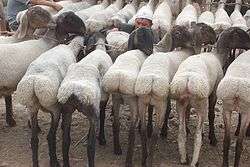Tail fat

Tail fat is the fat of some breeds of sheep, especially of fat-tailed sheep. It is fat accumulated in baggy deposits in the hind parts of a sheep on both sides of its tail and on the first 3–5 vertebrae of the tail. The weight of this part of a sheep's anatomy may be up to 30 kg (66 lb). These hind parts are used to accumulate fat for subsequent use during dry seasons, similar to a camel's humps.[1][2]
It is known under the name kurdyuk in Russian and in Central Asian languages,[3] from the proto-Turkic *kudruk 'tail'.[4][5]
Tail fat is known in Arabic as لية, (leeyeh, leyyah, or layeh), zaaka in Algeria, kuyruk yağ 'tail fat' in Turkish, and donbeh or dombeh in Persian,[1] words which may be found in local food culture and in sheep breeds' names.
The rendered tail fat does not solidify at room temperature and is used in cuisine.[2] Crackling left after the rendering or frying of kurdyuk may be used as an appetizer.[1][3] When being rendered, kurdyuk emits a strong odour, described as "acidy-poisonous". However, it has a rich flavor when ready to eat. In particular it is used to cook kofta, pilav, and other traditional dishes.[1]
References
- 1 2 3 4 Tilsley-Benham, Jill (1986). "Sheep with Two Tails: Sheep's Tail-Fat as Cooking Medium in the Middle East". Oxford Symposium on Food and Cookery. The Cooking Medium. p. 48.
- 1 2 "Курдюк". Brockhaus and Efron Encyclopedic Dictionary (in Russian). 1906.
- 1 2 Food Culture in Russia and Central Asia by Glenn Randall Mack, Asele Surina, p. 111, at Google Books
- ↑ Starostin, S. A.; Dybo, A. V.; Mudrak, O. A. (2003). An Etymological Dictionary of Altaic Languages. Boston: Bril. ISBN 90-04-13153-1.
- ↑ http://www.nisanyansozluk.com/?k=kuyruk